Business Communication: Units 10, 21, 24, 27, 32, 52, 54
VerifiedAdded on 2020/06/06
|21
|5882
|255
Homework Assignment
AI Summary
This homework assignment comprehensively addresses key facets of business communication, encompassing presentations, meetings, and customer service. The assignment begins by detailing best practices in developing presentations, including design, content, and audience consideration, as well as analyzing the advantages and limitations of various communication media like telephones and email. It then delves into effective meeting management, outlining purposes, attendance strategies, resources, and the roles of meeting chairs and secretaries. Furthermore, the assignment explores topics such as career pathways, information security, minute-taking, email best practices, and customer complaint resolution. The content covers Units 10, 21, 24, 27, 32, 52, and 54, offering a well-rounded perspective on communication strategies essential for business success. The assignment includes insights into formal and informal meetings, legal implications, and techniques for handling customer complaints, conflict management, and negotiation. The student's responses provide a thorough examination of each unit's core concepts and practical applications within a business context.
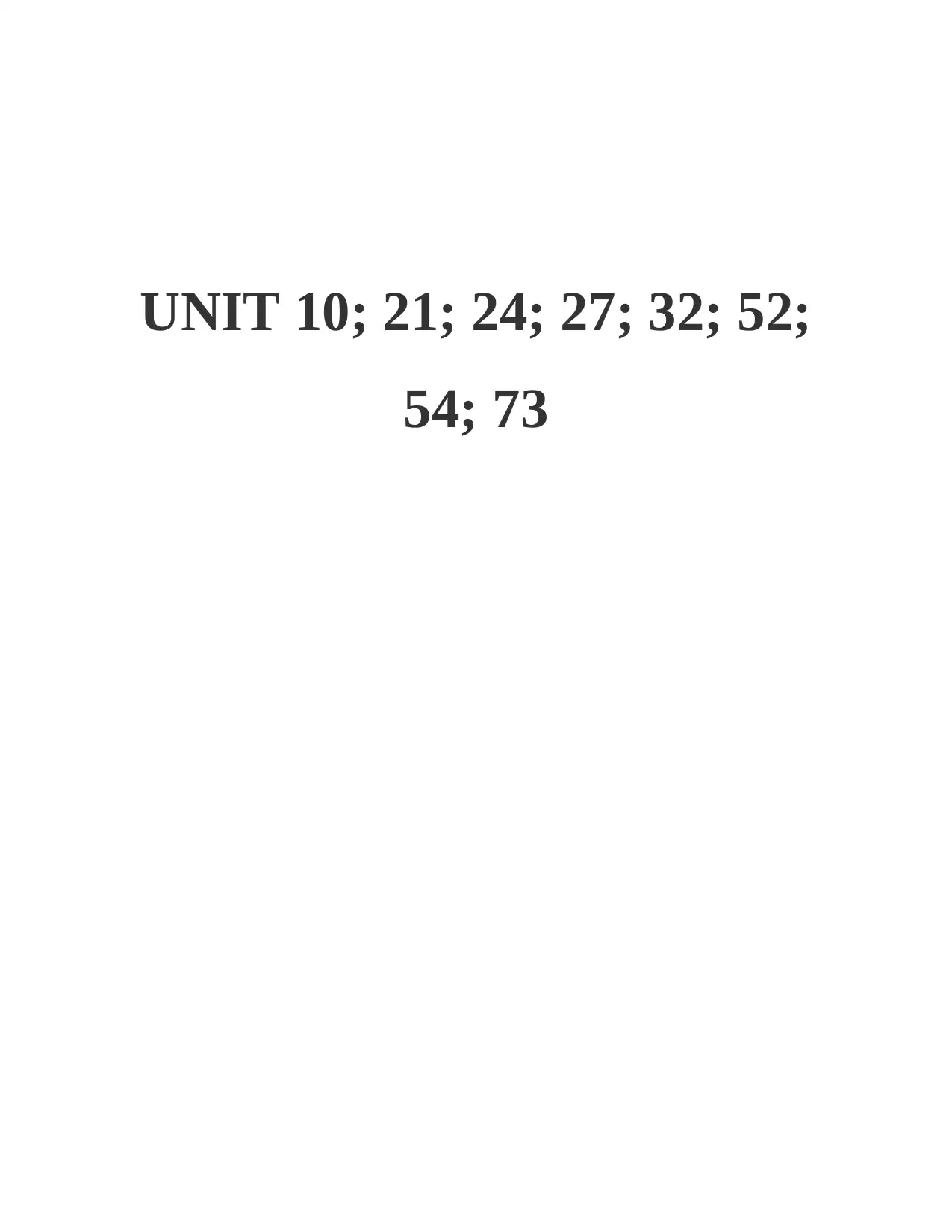
UNIT 10; 21; 24; 27; 32; 52;
54; 73
54; 73
Paraphrase This Document
Need a fresh take? Get an instant paraphrase of this document with our AI Paraphraser
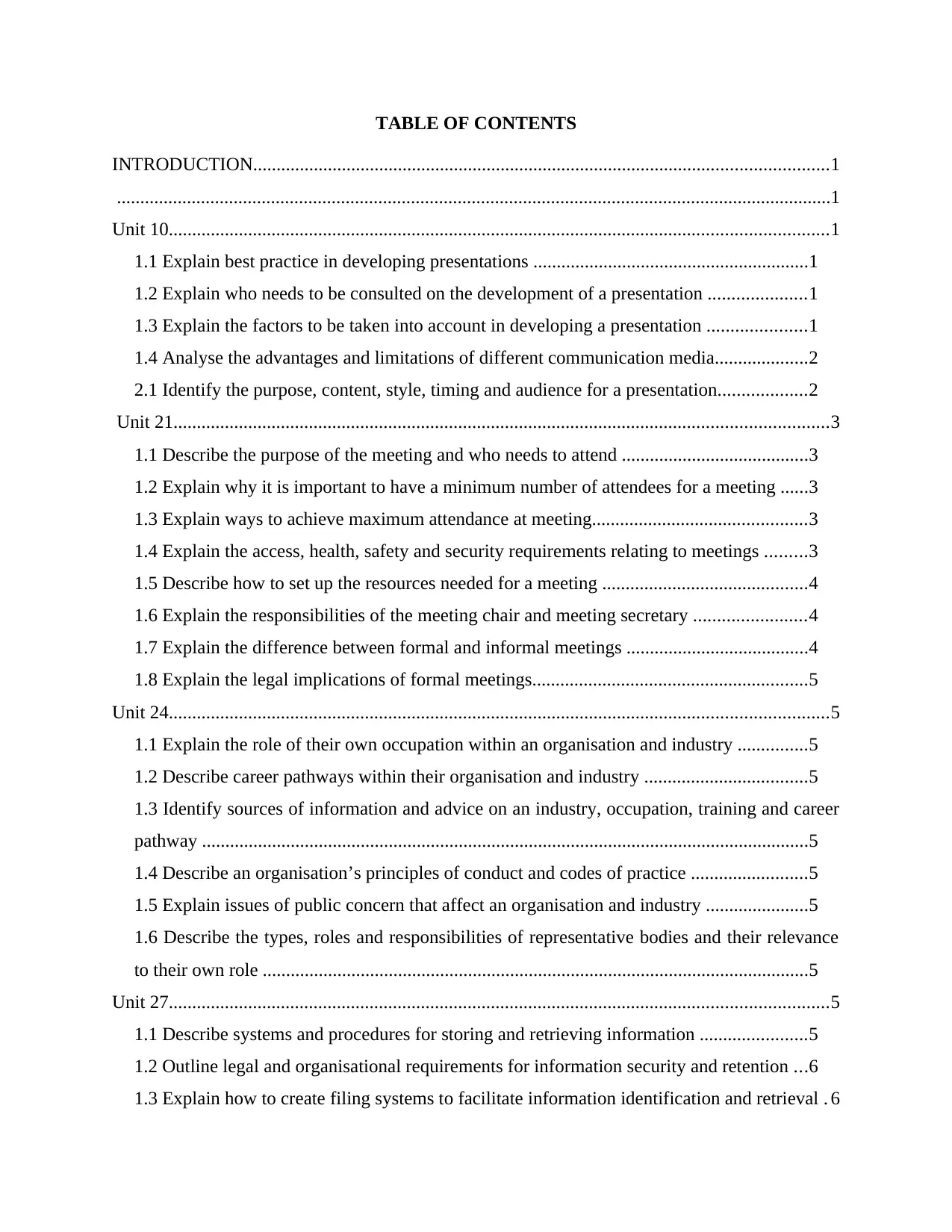
TABLE OF CONTENTS
INTRODUCTION...........................................................................................................................1
.........................................................................................................................................................1
Unit 10.............................................................................................................................................1
1.1 Explain best practice in developing presentations ...........................................................1
1.2 Explain who needs to be consulted on the development of a presentation .....................1
1.3 Explain the factors to be taken into account in developing a presentation .....................1
1.4 Analyse the advantages and limitations of different communication media....................2
2.1 Identify the purpose, content, style, timing and audience for a presentation...................2
Unit 21............................................................................................................................................3
1.1 Describe the purpose of the meeting and who needs to attend ........................................3
1.2 Explain why it is important to have a minimum number of attendees for a meeting ......3
1.3 Explain ways to achieve maximum attendance at meeting..............................................3
1.4 Explain the access, health, safety and security requirements relating to meetings .........3
1.5 Describe how to set up the resources needed for a meeting ............................................4
1.6 Explain the responsibilities of the meeting chair and meeting secretary ........................4
1.7 Explain the difference between formal and informal meetings .......................................4
1.8 Explain the legal implications of formal meetings...........................................................5
Unit 24.............................................................................................................................................5
1.1 Explain the role of their own occupation within an organisation and industry ...............5
1.2 Describe career pathways within their organisation and industry ...................................5
1.3 Identify sources of information and advice on an industry, occupation, training and career
pathway ..................................................................................................................................5
1.4 Describe an organisation’s principles of conduct and codes of practice .........................5
1.5 Explain issues of public concern that affect an organisation and industry ......................5
1.6 Describe the types, roles and responsibilities of representative bodies and their relevance
to their own role .....................................................................................................................5
Unit 27.............................................................................................................................................5
1.1 Describe systems and procedures for storing and retrieving information .......................5
1.2 Outline legal and organisational requirements for information security and retention ...6
1.3 Explain how to create filing systems to facilitate information identification and retrieval . 6
INTRODUCTION...........................................................................................................................1
.........................................................................................................................................................1
Unit 10.............................................................................................................................................1
1.1 Explain best practice in developing presentations ...........................................................1
1.2 Explain who needs to be consulted on the development of a presentation .....................1
1.3 Explain the factors to be taken into account in developing a presentation .....................1
1.4 Analyse the advantages and limitations of different communication media....................2
2.1 Identify the purpose, content, style, timing and audience for a presentation...................2
Unit 21............................................................................................................................................3
1.1 Describe the purpose of the meeting and who needs to attend ........................................3
1.2 Explain why it is important to have a minimum number of attendees for a meeting ......3
1.3 Explain ways to achieve maximum attendance at meeting..............................................3
1.4 Explain the access, health, safety and security requirements relating to meetings .........3
1.5 Describe how to set up the resources needed for a meeting ............................................4
1.6 Explain the responsibilities of the meeting chair and meeting secretary ........................4
1.7 Explain the difference between formal and informal meetings .......................................4
1.8 Explain the legal implications of formal meetings...........................................................5
Unit 24.............................................................................................................................................5
1.1 Explain the role of their own occupation within an organisation and industry ...............5
1.2 Describe career pathways within their organisation and industry ...................................5
1.3 Identify sources of information and advice on an industry, occupation, training and career
pathway ..................................................................................................................................5
1.4 Describe an organisation’s principles of conduct and codes of practice .........................5
1.5 Explain issues of public concern that affect an organisation and industry ......................5
1.6 Describe the types, roles and responsibilities of representative bodies and their relevance
to their own role .....................................................................................................................5
Unit 27.............................................................................................................................................5
1.1 Describe systems and procedures for storing and retrieving information .......................5
1.2 Outline legal and organisational requirements for information security and retention ...6
1.3 Explain how to create filing systems to facilitate information identification and retrieval . 6

1.4 Using different search techniques...................................................................................6
1.5 What to do at the time of arising problems......................................................................6
Unit 32.............................................................................................................................................7
1.1 Explain the purpose of different typesof minutes and other meeting records..................7
Types of minutes....................................................................................................................7
1.2 Legal requirements of formal minutes.............................................................................7
1.3 Organisational conventions for producing minutes..........................................................8
1.4 Responsibilities of the minute taker.................................................................................8
1.5 Importance of maintaining confidentiality.......................................................................8
1.6 Requirement of recording.................................................................................................8
UNIT 52...........................................................................................................................................9
1.2 Explain methods to improve message transmission.........................................................9
1.4 Explain why and how to stay safe and respect others when using e-mail........................9
2.4 Explain why, how and when to archive messages..........................................................9
2.7 Explain how to minimise e-mail problems......................................................................9
UNIT 54.........................................................................................................................................10
1.2 Explain how to identify those complaints that should prompt a review of the service offer
and service delivery..............................................................................................................10
1.3 Explain negotiating techniques used to resolve customers’ complaints........................10
Listen to the customer..........................................................................................................10
1.4 Explain conflict management techniques used in dealing with upset customers...........10
1.5 Explain organisational procedures for dealing with customer complaints....................11
1.6 Explain when to escalate customers’ complaints..........................................................11
1.7 Explain the cost and regulatory implications of admitting liability on the basis of a
customer complaint..............................................................................................................11
1.8 Explain the advantages and limitations of offering compensation or replacement products
and/or services......................................................................................................................11
2.4 Explain the advantages and limitations of different complaint response options to
customers..............................................................................................................................12
2.5 Explain the advantages and limitations of different complaint response options to the
organisation..........................................................................................................................12
1.5 What to do at the time of arising problems......................................................................6
Unit 32.............................................................................................................................................7
1.1 Explain the purpose of different typesof minutes and other meeting records..................7
Types of minutes....................................................................................................................7
1.2 Legal requirements of formal minutes.............................................................................7
1.3 Organisational conventions for producing minutes..........................................................8
1.4 Responsibilities of the minute taker.................................................................................8
1.5 Importance of maintaining confidentiality.......................................................................8
1.6 Requirement of recording.................................................................................................8
UNIT 52...........................................................................................................................................9
1.2 Explain methods to improve message transmission.........................................................9
1.4 Explain why and how to stay safe and respect others when using e-mail........................9
2.4 Explain why, how and when to archive messages..........................................................9
2.7 Explain how to minimise e-mail problems......................................................................9
UNIT 54.........................................................................................................................................10
1.2 Explain how to identify those complaints that should prompt a review of the service offer
and service delivery..............................................................................................................10
1.3 Explain negotiating techniques used to resolve customers’ complaints........................10
Listen to the customer..........................................................................................................10
1.4 Explain conflict management techniques used in dealing with upset customers...........10
1.5 Explain organisational procedures for dealing with customer complaints....................11
1.6 Explain when to escalate customers’ complaints..........................................................11
1.7 Explain the cost and regulatory implications of admitting liability on the basis of a
customer complaint..............................................................................................................11
1.8 Explain the advantages and limitations of offering compensation or replacement products
and/or services......................................................................................................................11
2.4 Explain the advantages and limitations of different complaint response options to
customers..............................................................................................................................12
2.5 Explain the advantages and limitations of different complaint response options to the
organisation..........................................................................................................................12
⊘ This is a preview!⊘
Do you want full access?
Subscribe today to unlock all pages.

Trusted by 1+ million students worldwide

CONCLUSION..............................................................................................................................12
Paraphrase This Document
Need a fresh take? Get an instant paraphrase of this document with our AI Paraphraser

INTRODUCTION
Unit 10
1.1 Explain best practice in developing presentations
Design
Hopefully you already have a company slide template, but if not, apply a clean and simple design
based on the colour palette and font of your brand for visual consistency.
Content
Two words: reuse & shorten. If your website is current, effectively designed and includes
targeted content throughout, use this as your source material, and then convert it into
slides for optimal reuse.
Script
Everyone in your company has a different way of describing the same diagram or mission
statement, so a script is key to making sure all the presenters deliver the same message
consistently and coherently (Abdillah, 2017).
Customization
After all the work to polish and standardize your message, make sure the presentation is
customizable for each audience.
1.2 Explain who needs to be consulted on the development of a presentation
The top management and board of directors must be consulted while developing a
presentation. Besides this, the person who is developing the presentation must be consulted about
the information and data needed to be included in it.
1.3 Explain the factors to be taken into account in developing a presentation
Telling a story is always an amazing way to present an idea. If you are a good storyteller,
stick to small number of slides to accentuate the story and let your speech do the talking.
If you are presenting how-to’s or other structured information it is a good idea to build
slides that highlight your key points, steps or statistics (Thill and BOVÉE, 2014).
If you are presenting structured information, use bullet points, not sentences or
paragraphs to help your viewers’ eyes scan through the slide and catch each point.
1
Unit 10
1.1 Explain best practice in developing presentations
Design
Hopefully you already have a company slide template, but if not, apply a clean and simple design
based on the colour palette and font of your brand for visual consistency.
Content
Two words: reuse & shorten. If your website is current, effectively designed and includes
targeted content throughout, use this as your source material, and then convert it into
slides for optimal reuse.
Script
Everyone in your company has a different way of describing the same diagram or mission
statement, so a script is key to making sure all the presenters deliver the same message
consistently and coherently (Abdillah, 2017).
Customization
After all the work to polish and standardize your message, make sure the presentation is
customizable for each audience.
1.2 Explain who needs to be consulted on the development of a presentation
The top management and board of directors must be consulted while developing a
presentation. Besides this, the person who is developing the presentation must be consulted about
the information and data needed to be included in it.
1.3 Explain the factors to be taken into account in developing a presentation
Telling a story is always an amazing way to present an idea. If you are a good storyteller,
stick to small number of slides to accentuate the story and let your speech do the talking.
If you are presenting how-to’s or other structured information it is a good idea to build
slides that highlight your key points, steps or statistics (Thill and BOVÉE, 2014).
If you are presenting structured information, use bullet points, not sentences or
paragraphs to help your viewers’ eyes scan through the slide and catch each point.
1
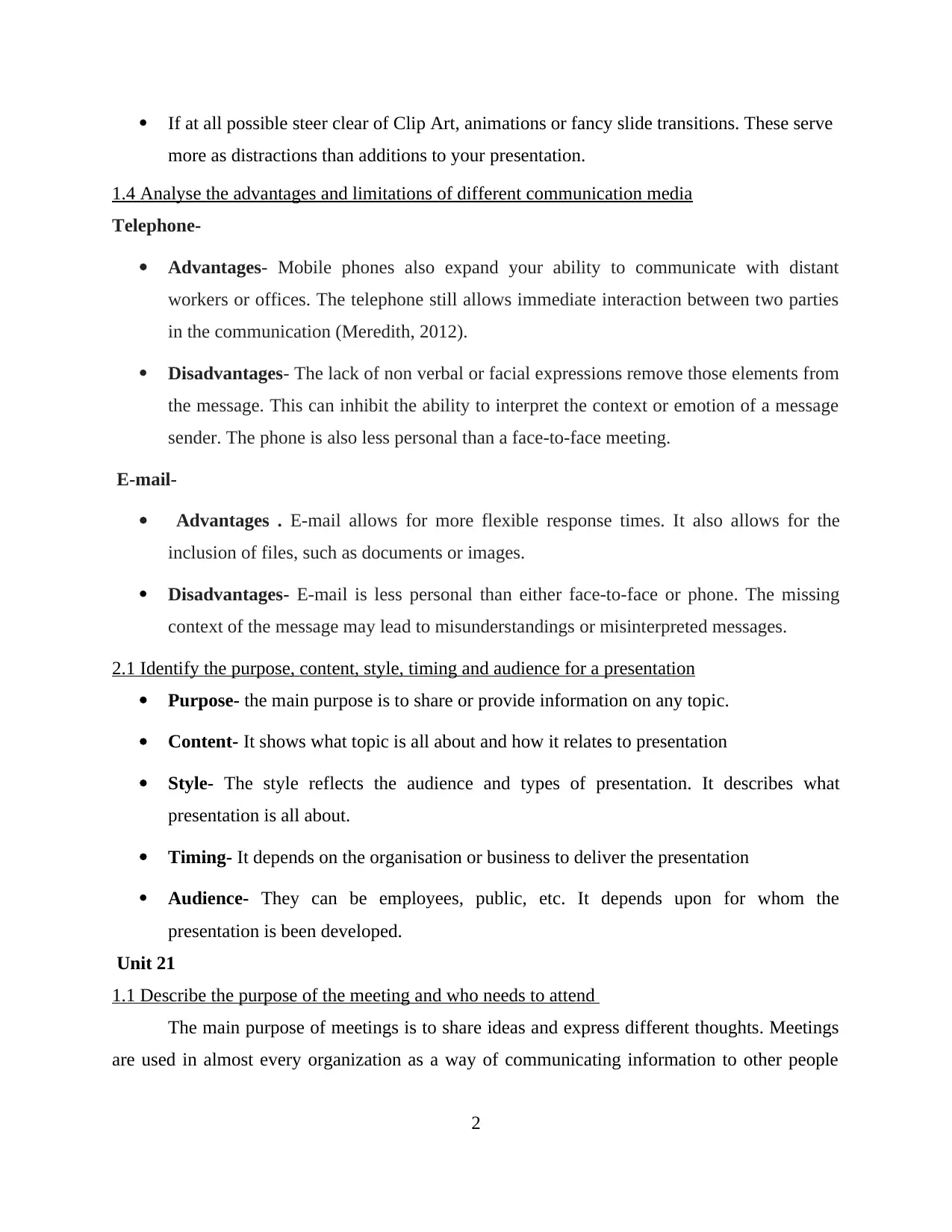
If at all possible steer clear of Clip Art, animations or fancy slide transitions. These serve
more as distractions than additions to your presentation.
1.4 Analyse the advantages and limitations of different communication media
Telephone-
Advantages- Mobile phones also expand your ability to communicate with distant
workers or offices. The telephone still allows immediate interaction between two parties
in the communication (Meredith, 2012).
Disadvantages- The lack of non verbal or facial expressions remove those elements from
the message. This can inhibit the ability to interpret the context or emotion of a message
sender. The phone is also less personal than a face-to-face meeting.
E-mail-
Advantages . E-mail allows for more flexible response times. It also allows for the
inclusion of files, such as documents or images.
Disadvantages- E-mail is less personal than either face-to-face or phone. The missing
context of the message may lead to misunderstandings or misinterpreted messages.
2.1 Identify the purpose, content, style, timing and audience for a presentation
Purpose- the main purpose is to share or provide information on any topic.
Content- It shows what topic is all about and how it relates to presentation
Style- The style reflects the audience and types of presentation. It describes what
presentation is all about.
Timing- It depends on the organisation or business to deliver the presentation
Audience- They can be employees, public, etc. It depends upon for whom the
presentation is been developed.
Unit 21
1.1 Describe the purpose of the meeting and who needs to attend
The main purpose of meetings is to share ideas and express different thoughts. Meetings
are used in almost every organization as a way of communicating information to other people
2
more as distractions than additions to your presentation.
1.4 Analyse the advantages and limitations of different communication media
Telephone-
Advantages- Mobile phones also expand your ability to communicate with distant
workers or offices. The telephone still allows immediate interaction between two parties
in the communication (Meredith, 2012).
Disadvantages- The lack of non verbal or facial expressions remove those elements from
the message. This can inhibit the ability to interpret the context or emotion of a message
sender. The phone is also less personal than a face-to-face meeting.
E-mail-
Advantages . E-mail allows for more flexible response times. It also allows for the
inclusion of files, such as documents or images.
Disadvantages- E-mail is less personal than either face-to-face or phone. The missing
context of the message may lead to misunderstandings or misinterpreted messages.
2.1 Identify the purpose, content, style, timing and audience for a presentation
Purpose- the main purpose is to share or provide information on any topic.
Content- It shows what topic is all about and how it relates to presentation
Style- The style reflects the audience and types of presentation. It describes what
presentation is all about.
Timing- It depends on the organisation or business to deliver the presentation
Audience- They can be employees, public, etc. It depends upon for whom the
presentation is been developed.
Unit 21
1.1 Describe the purpose of the meeting and who needs to attend
The main purpose of meetings is to share ideas and express different thoughts. Meetings
are used in almost every organization as a way of communicating information to other people
2
⊘ This is a preview!⊘
Do you want full access?
Subscribe today to unlock all pages.

Trusted by 1+ million students worldwide
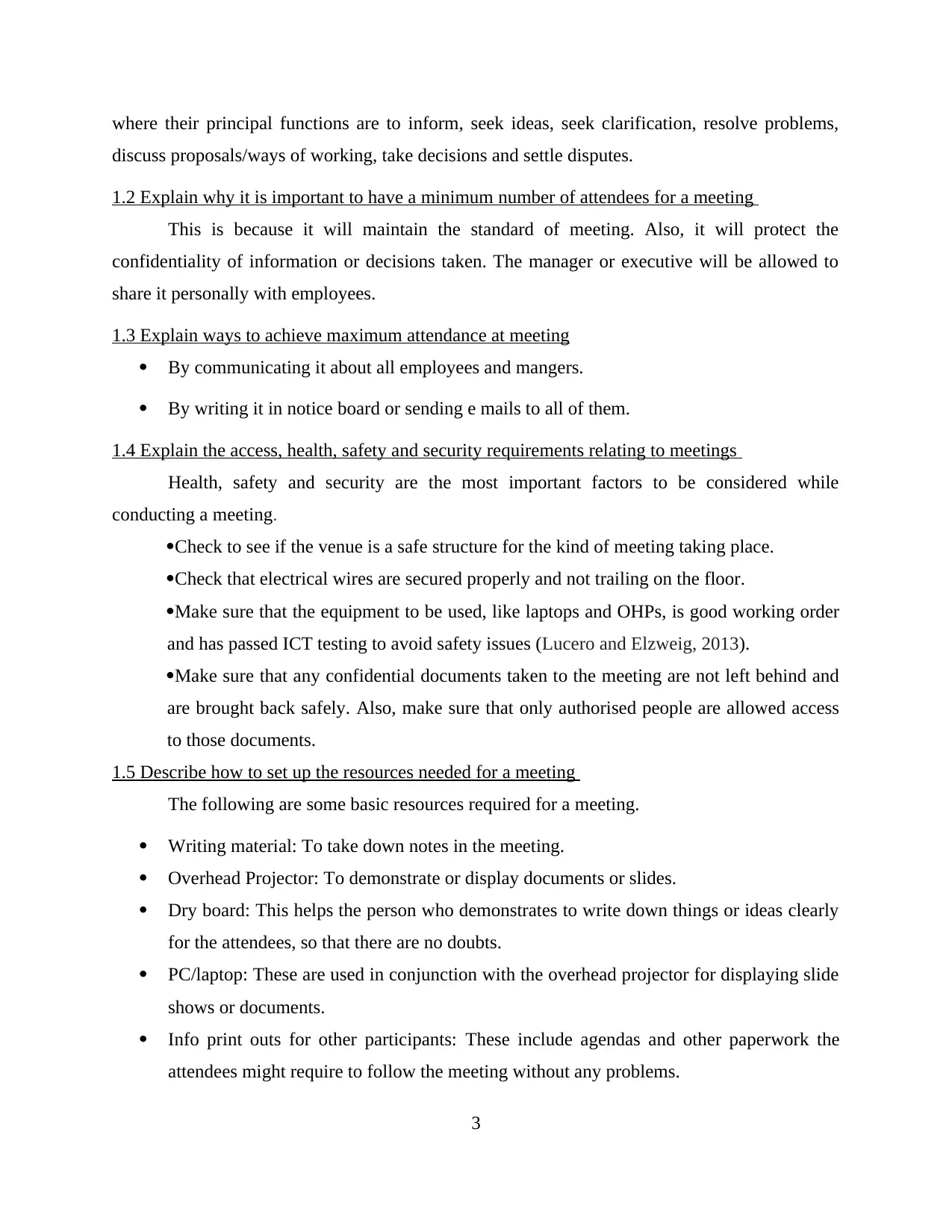
where their principal functions are to inform, seek ideas, seek clarification, resolve problems,
discuss proposals/ways of working, take decisions and settle disputes.
1.2 Explain why it is important to have a minimum number of attendees for a meeting
This is because it will maintain the standard of meeting. Also, it will protect the
confidentiality of information or decisions taken. The manager or executive will be allowed to
share it personally with employees.
1.3 Explain ways to achieve maximum attendance at meeting
By communicating it about all employees and mangers.
By writing it in notice board or sending e mails to all of them.
1.4 Explain the access, health, safety and security requirements relating to meetings
Health, safety and security are the most important factors to be considered while
conducting a meeting.
Check to see if the venue is a safe structure for the kind of meeting taking place.
Check that electrical wires are secured properly and not trailing on the floor.
Make sure that the equipment to be used, like laptops and OHPs, is good working order
and has passed ICT testing to avoid safety issues (Lucero and Elzweig, 2013).
Make sure that any confidential documents taken to the meeting are not left behind and
are brought back safely. Also, make sure that only authorised people are allowed access
to those documents.
1.5 Describe how to set up the resources needed for a meeting
The following are some basic resources required for a meeting.
Writing material: To take down notes in the meeting.
Overhead Projector: To demonstrate or display documents or slides.
Dry board: This helps the person who demonstrates to write down things or ideas clearly
for the attendees, so that there are no doubts.
PC/laptop: These are used in conjunction with the overhead projector for displaying slide
shows or documents.
Info print outs for other participants: These include agendas and other paperwork the
attendees might require to follow the meeting without any problems.
3
discuss proposals/ways of working, take decisions and settle disputes.
1.2 Explain why it is important to have a minimum number of attendees for a meeting
This is because it will maintain the standard of meeting. Also, it will protect the
confidentiality of information or decisions taken. The manager or executive will be allowed to
share it personally with employees.
1.3 Explain ways to achieve maximum attendance at meeting
By communicating it about all employees and mangers.
By writing it in notice board or sending e mails to all of them.
1.4 Explain the access, health, safety and security requirements relating to meetings
Health, safety and security are the most important factors to be considered while
conducting a meeting.
Check to see if the venue is a safe structure for the kind of meeting taking place.
Check that electrical wires are secured properly and not trailing on the floor.
Make sure that the equipment to be used, like laptops and OHPs, is good working order
and has passed ICT testing to avoid safety issues (Lucero and Elzweig, 2013).
Make sure that any confidential documents taken to the meeting are not left behind and
are brought back safely. Also, make sure that only authorised people are allowed access
to those documents.
1.5 Describe how to set up the resources needed for a meeting
The following are some basic resources required for a meeting.
Writing material: To take down notes in the meeting.
Overhead Projector: To demonstrate or display documents or slides.
Dry board: This helps the person who demonstrates to write down things or ideas clearly
for the attendees, so that there are no doubts.
PC/laptop: These are used in conjunction with the overhead projector for displaying slide
shows or documents.
Info print outs for other participants: These include agendas and other paperwork the
attendees might require to follow the meeting without any problems.
3
Paraphrase This Document
Need a fresh take? Get an instant paraphrase of this document with our AI Paraphraser
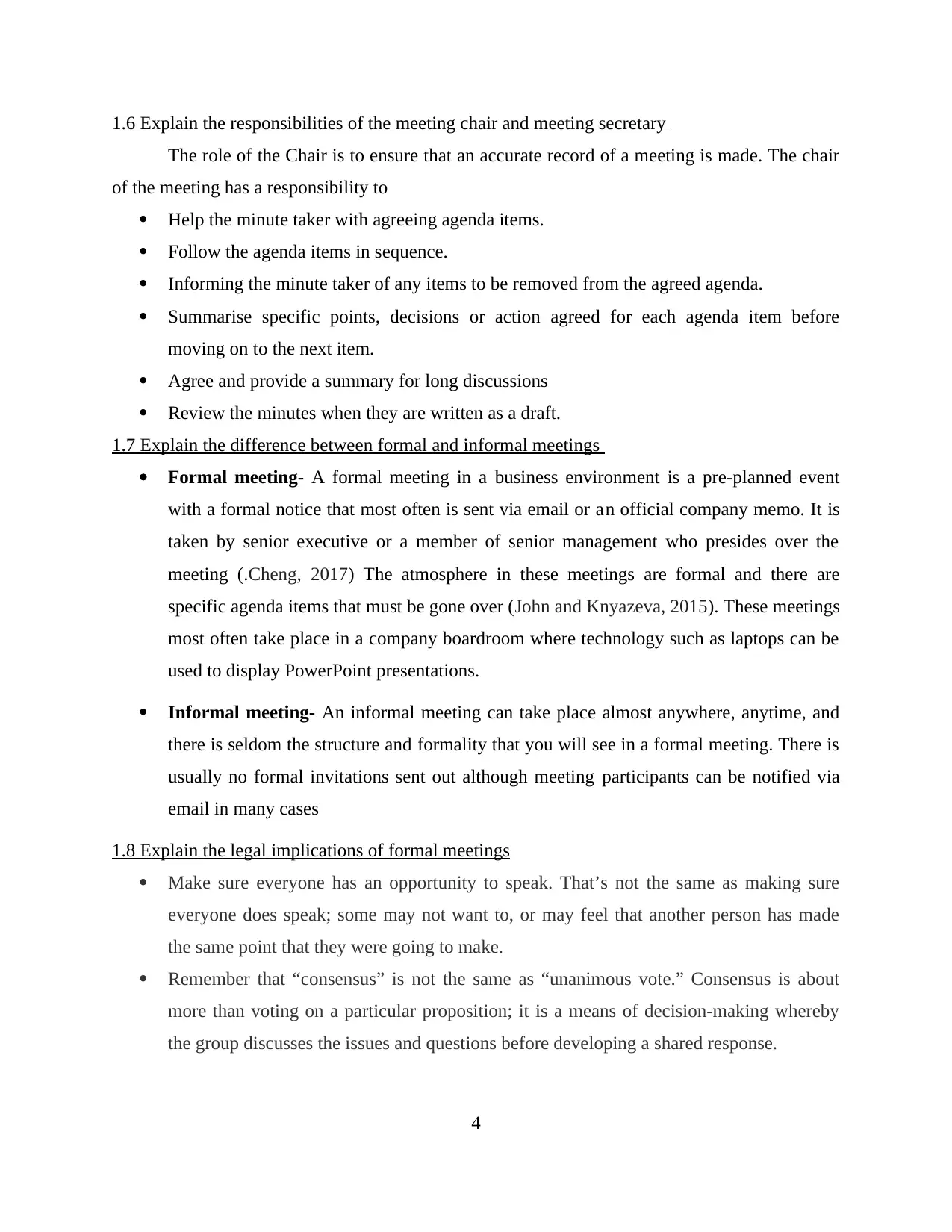
1.6 Explain the responsibilities of the meeting chair and meeting secretary
The role of the Chair is to ensure that an accurate record of a meeting is made. The chair
of the meeting has a responsibility to
Help the minute taker with agreeing agenda items.
Follow the agenda items in sequence.
Informing the minute taker of any items to be removed from the agreed agenda.
Summarise specific points, decisions or action agreed for each agenda item before
moving on to the next item.
Agree and provide a summary for long discussions
Review the minutes when they are written as a draft.
1.7 Explain the difference between formal and informal meetings
Formal meeting- A formal meeting in a business environment is a pre-planned event
with a formal notice that most often is sent via email or an official company memo. It is
taken by senior executive or a member of senior management who presides over the
meeting (.Cheng, 2017) The atmosphere in these meetings are formal and there are
specific agenda items that must be gone over (John and Knyazeva, 2015). These meetings
most often take place in a company boardroom where technology such as laptops can be
used to display PowerPoint presentations.
Informal meeting- An informal meeting can take place almost anywhere, anytime, and
there is seldom the structure and formality that you will see in a formal meeting. There is
usually no formal invitations sent out although meeting participants can be notified via
email in many cases
1.8 Explain the legal implications of formal meetings
Make sure everyone has an opportunity to speak. That’s not the same as making sure
everyone does speak; some may not want to, or may feel that another person has made
the same point that they were going to make.
Remember that “consensus” is not the same as “unanimous vote.” Consensus is about
more than voting on a particular proposition; it is a means of decision-making whereby
the group discusses the issues and questions before developing a shared response.
4
The role of the Chair is to ensure that an accurate record of a meeting is made. The chair
of the meeting has a responsibility to
Help the minute taker with agreeing agenda items.
Follow the agenda items in sequence.
Informing the minute taker of any items to be removed from the agreed agenda.
Summarise specific points, decisions or action agreed for each agenda item before
moving on to the next item.
Agree and provide a summary for long discussions
Review the minutes when they are written as a draft.
1.7 Explain the difference between formal and informal meetings
Formal meeting- A formal meeting in a business environment is a pre-planned event
with a formal notice that most often is sent via email or an official company memo. It is
taken by senior executive or a member of senior management who presides over the
meeting (.Cheng, 2017) The atmosphere in these meetings are formal and there are
specific agenda items that must be gone over (John and Knyazeva, 2015). These meetings
most often take place in a company boardroom where technology such as laptops can be
used to display PowerPoint presentations.
Informal meeting- An informal meeting can take place almost anywhere, anytime, and
there is seldom the structure and formality that you will see in a formal meeting. There is
usually no formal invitations sent out although meeting participants can be notified via
email in many cases
1.8 Explain the legal implications of formal meetings
Make sure everyone has an opportunity to speak. That’s not the same as making sure
everyone does speak; some may not want to, or may feel that another person has made
the same point that they were going to make.
Remember that “consensus” is not the same as “unanimous vote.” Consensus is about
more than voting on a particular proposition; it is a means of decision-making whereby
the group discusses the issues and questions before developing a shared response.
4
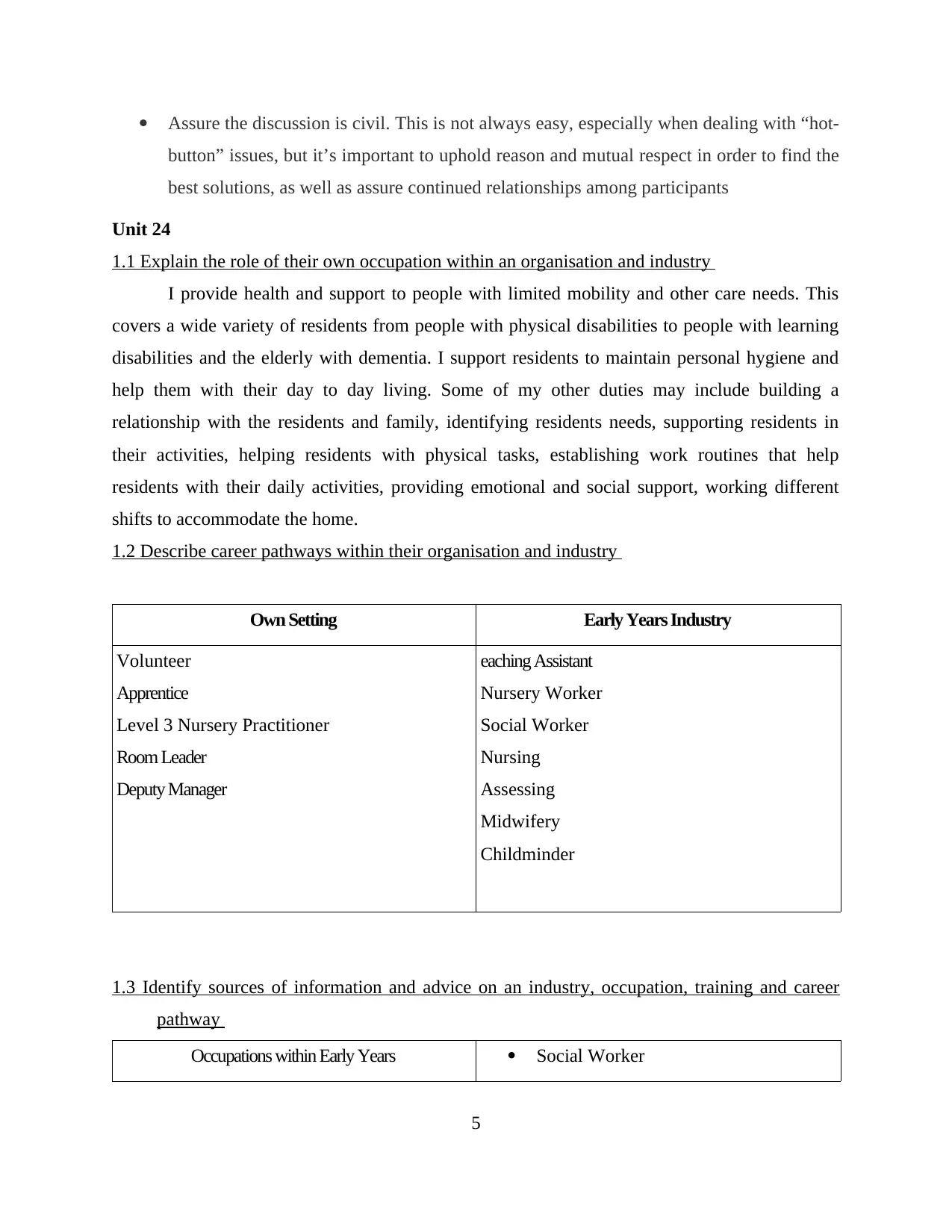
Assure the discussion is civil. This is not always easy, especially when dealing with “hot-
button” issues, but it’s important to uphold reason and mutual respect in order to find the
best solutions, as well as assure continued relationships among participants
Unit 24
1.1 Explain the role of their own occupation within an organisation and industry
I provide health and support to people with limited mobility and other care needs. This
covers a wide variety of residents from people with physical disabilities to people with learning
disabilities and the elderly with dementia. I support residents to maintain personal hygiene and
help them with their day to day living. Some of my other duties may include building a
relationship with the residents and family, identifying residents needs, supporting residents in
their activities, helping residents with physical tasks, establishing work routines that help
residents with their daily activities, providing emotional and social support, working different
shifts to accommodate the home.
1.2 Describe career pathways within their organisation and industry
Own Setting Early Years Industry
Volunteer
Apprentice
Level 3 Nursery Practitioner
Room Leader
Deputy Manager
eaching Assistant
Nursery Worker
Social Worker
Nursing
Assessing
Midwifery
Childminder
1.3 Identify sources of information and advice on an industry, occupation, training and career
pathway
Occupations within Early Years Social Worker
5
button” issues, but it’s important to uphold reason and mutual respect in order to find the
best solutions, as well as assure continued relationships among participants
Unit 24
1.1 Explain the role of their own occupation within an organisation and industry
I provide health and support to people with limited mobility and other care needs. This
covers a wide variety of residents from people with physical disabilities to people with learning
disabilities and the elderly with dementia. I support residents to maintain personal hygiene and
help them with their day to day living. Some of my other duties may include building a
relationship with the residents and family, identifying residents needs, supporting residents in
their activities, helping residents with physical tasks, establishing work routines that help
residents with their daily activities, providing emotional and social support, working different
shifts to accommodate the home.
1.2 Describe career pathways within their organisation and industry
Own Setting Early Years Industry
Volunteer
Apprentice
Level 3 Nursery Practitioner
Room Leader
Deputy Manager
eaching Assistant
Nursery Worker
Social Worker
Nursing
Assessing
Midwifery
Childminder
1.3 Identify sources of information and advice on an industry, occupation, training and career
pathway
Occupations within Early Years Social Worker
5
⊘ This is a preview!⊘
Do you want full access?
Subscribe today to unlock all pages.

Trusted by 1+ million students worldwide
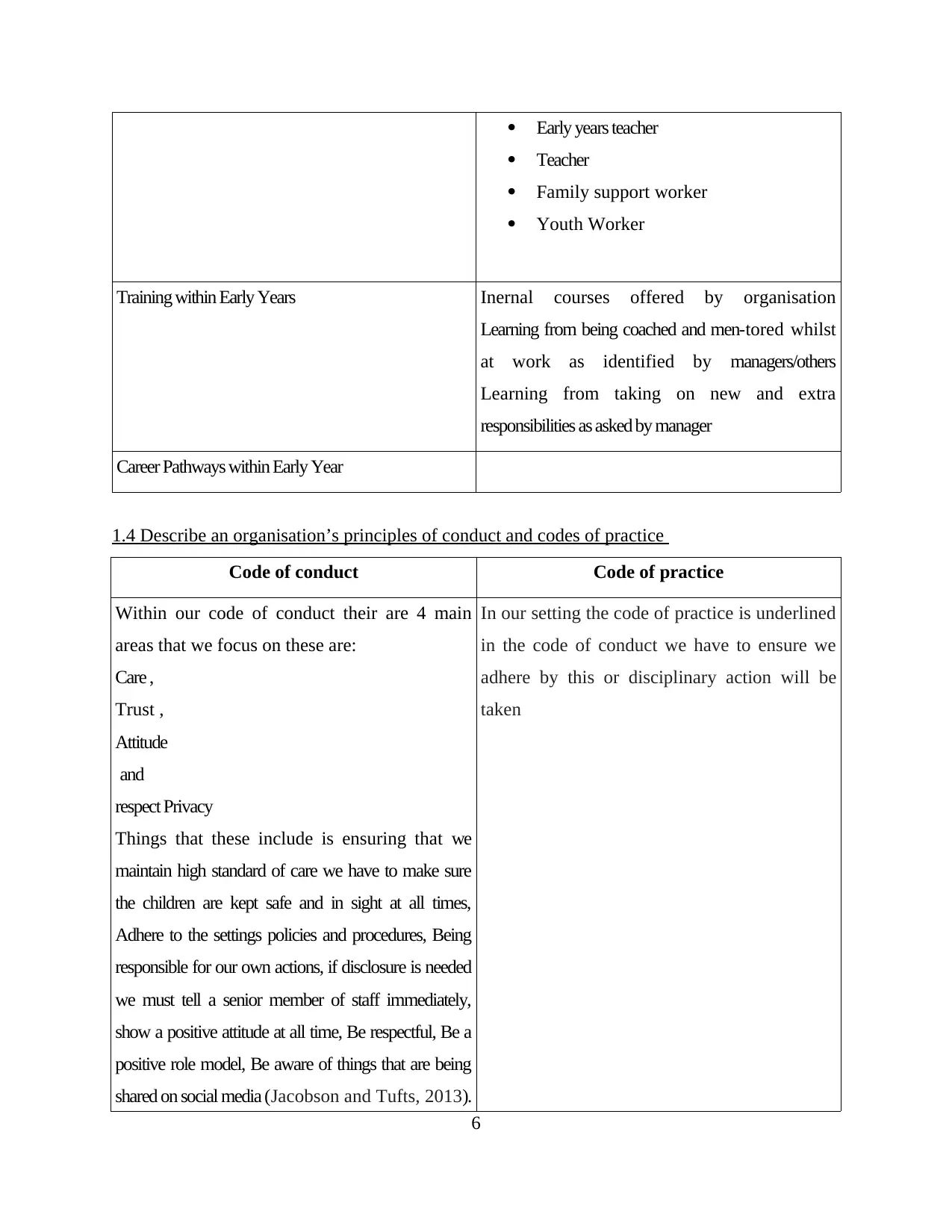
Early years teacher
Teacher
Family support worker
Youth Worker
Training within Early Years Inernal courses offered by organisation
Learning from being coached and men-tored whilst
at work as identified by managers/others
Learning from taking on new and extra
responsibilities as asked by manager
Career Pathways within Early Year
1.4 Describe an organisation’s principles of conduct and codes of practice
Code of conduct Code of practice
Within our code of conduct their are 4 main
areas that we focus on these are:
Care ,
Trust ,
Attitude
and
respect Privacy
Things that these include is ensuring that we
maintain high standard of care we have to make sure
the children are kept safe and in sight at all times,
Adhere to the settings policies and procedures, Being
responsible for our own actions, if disclosure is needed
we must tell a senior member of staff immediately,
show a positive attitude at all time, Be respectful, Be a
positive role model, Be aware of things that are being
shared on social media (Jacobson and Tufts, 2013).
In our setting the code of practice is underlined
in the code of conduct we have to ensure we
adhere by this or disciplinary action will be
taken
6
Teacher
Family support worker
Youth Worker
Training within Early Years Inernal courses offered by organisation
Learning from being coached and men-tored whilst
at work as identified by managers/others
Learning from taking on new and extra
responsibilities as asked by manager
Career Pathways within Early Year
1.4 Describe an organisation’s principles of conduct and codes of practice
Code of conduct Code of practice
Within our code of conduct their are 4 main
areas that we focus on these are:
Care ,
Trust ,
Attitude
and
respect Privacy
Things that these include is ensuring that we
maintain high standard of care we have to make sure
the children are kept safe and in sight at all times,
Adhere to the settings policies and procedures, Being
responsible for our own actions, if disclosure is needed
we must tell a senior member of staff immediately,
show a positive attitude at all time, Be respectful, Be a
positive role model, Be aware of things that are being
shared on social media (Jacobson and Tufts, 2013).
In our setting the code of practice is underlined
in the code of conduct we have to ensure we
adhere by this or disciplinary action will be
taken
6
Paraphrase This Document
Need a fresh take? Get an instant paraphrase of this document with our AI Paraphraser
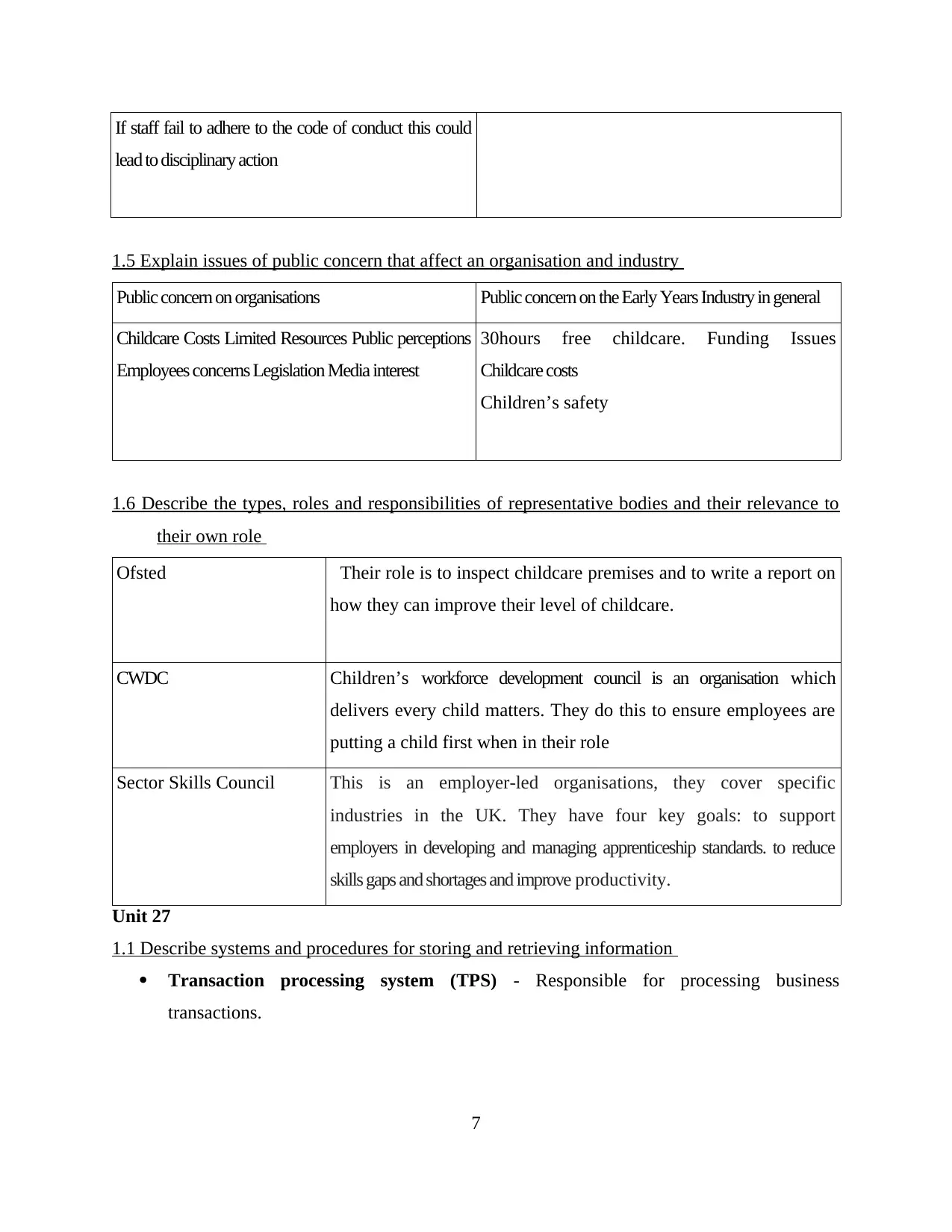
If staff fail to adhere to the code of conduct this could
lead to disciplinary action
1.5 Explain issues of public concern that affect an organisation and industry
Public concern on organisations Public concern on the Early Years Industry in general
Childcare Costs Limited Resources Public perceptions
Employees concerns Legislation Media interest
30hours free childcare. Funding Issues
Childcare costs
Children’s safety
1.6 Describe the types, roles and responsibilities of representative bodies and their relevance to
their own role
Ofsted Their role is to inspect childcare premises and to write a report on
how they can improve their level of childcare.
CWDC Children’s workforce development council is an organisation which
delivers every child matters. They do this to ensure employees are
putting a child first when in their role
Sector Skills Council This is an employer-led organisations, they cover specific
industries in the UK. They have four key goals: to support
employers in developing and managing apprenticeship standards. to reduce
skills gaps and shortages and improve productivity.
Unit 27
1.1 Describe systems and procedures for storing and retrieving information
Transaction processing system (TPS) - Responsible for processing business
transactions.
7
lead to disciplinary action
1.5 Explain issues of public concern that affect an organisation and industry
Public concern on organisations Public concern on the Early Years Industry in general
Childcare Costs Limited Resources Public perceptions
Employees concerns Legislation Media interest
30hours free childcare. Funding Issues
Childcare costs
Children’s safety
1.6 Describe the types, roles and responsibilities of representative bodies and their relevance to
their own role
Ofsted Their role is to inspect childcare premises and to write a report on
how they can improve their level of childcare.
CWDC Children’s workforce development council is an organisation which
delivers every child matters. They do this to ensure employees are
putting a child first when in their role
Sector Skills Council This is an employer-led organisations, they cover specific
industries in the UK. They have four key goals: to support
employers in developing and managing apprenticeship standards. to reduce
skills gaps and shortages and improve productivity.
Unit 27
1.1 Describe systems and procedures for storing and retrieving information
Transaction processing system (TPS) - Responsible for processing business
transactions.
7

Management information system - Helps with carrying out the tasks required for
problem solving and decision making. They help management by monitoring
performance, efficiency, accounting, and transactional data (Hynes, 2012).
Decision support systems - Assists managers in decision making. It uses internal and
external resources to analyse existing information and project the effects.
Customer relationship management (CRM) systems - Business owners use customer
relationship systems to accumulate and track customer activities, including purchases,
product defects, and customer inquiries.
Business Intelligence Systems (BIS) - Provide analyses that predict future sales patterns,
summarise current costs, and forecast sales revenues.
1.2 Outline legal and organisational requirements for information security and retention
It is important to have rules concerning the security and confidentiality of information,
because it may contain sensitive data such as:
Personal records
Payroll records
Human resources records
Financial data
In the wrong hands, this information could pose a threat to the business and its customers or be
used to commit fraud, discrimination, and other violations.
There are laws such as the 1998 Data Protection Act that, if not followed, could lead to legal
action.
1.3 Explain how to create filing systems to facilitate information identification and retrieval
Organisations cannot keep all the information they obtain. Storing wrong or irrelevant
information is of no use and takes up valuable space, making retrieving information more
difficulty.
When making decisions on which information should be stored, the decision will depend
first and foremost on the legal requirements relating to each particular type of information. For
example, legal requirements state that:
8
problem solving and decision making. They help management by monitoring
performance, efficiency, accounting, and transactional data (Hynes, 2012).
Decision support systems - Assists managers in decision making. It uses internal and
external resources to analyse existing information and project the effects.
Customer relationship management (CRM) systems - Business owners use customer
relationship systems to accumulate and track customer activities, including purchases,
product defects, and customer inquiries.
Business Intelligence Systems (BIS) - Provide analyses that predict future sales patterns,
summarise current costs, and forecast sales revenues.
1.2 Outline legal and organisational requirements for information security and retention
It is important to have rules concerning the security and confidentiality of information,
because it may contain sensitive data such as:
Personal records
Payroll records
Human resources records
Financial data
In the wrong hands, this information could pose a threat to the business and its customers or be
used to commit fraud, discrimination, and other violations.
There are laws such as the 1998 Data Protection Act that, if not followed, could lead to legal
action.
1.3 Explain how to create filing systems to facilitate information identification and retrieval
Organisations cannot keep all the information they obtain. Storing wrong or irrelevant
information is of no use and takes up valuable space, making retrieving information more
difficulty.
When making decisions on which information should be stored, the decision will depend
first and foremost on the legal requirements relating to each particular type of information. For
example, legal requirements state that:
8
⊘ This is a preview!⊘
Do you want full access?
Subscribe today to unlock all pages.

Trusted by 1+ million students worldwide
1 out of 21
Related Documents
Your All-in-One AI-Powered Toolkit for Academic Success.
+13062052269
info@desklib.com
Available 24*7 on WhatsApp / Email
![[object Object]](/_next/static/media/star-bottom.7253800d.svg)
Unlock your academic potential
Copyright © 2020–2025 A2Z Services. All Rights Reserved. Developed and managed by ZUCOL.





